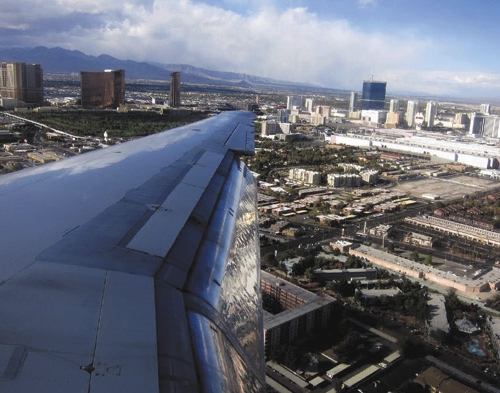Flights, airline seats to LV rising in ’11
The airline schedules through the first half of next year show modest gains in the number of flights and seats at McCarran International Airport after four years of cutbacks.
The rate of improvement in local air service will accelerate as the year goes on, but will remain in low single-digit percentages and will leave local air traffic well below the levels of 2007. Some analysts doubt whether the budding rebound is hefty enough yet to improve the financial fortunes of the Strip's gaming companies.
Statistics compiled by the trade group Air Transport Association show that the number of seats into the market will rise to an average of 438,000 per week in January, 0.7 percent better than the same month a year earlier. The growth rate will rise steadily to 2.8 percent in June, when the airlines plan to have 473,000 seats a week.
This still falls 17 percent short of the 555,000 seats coming into and out of McCarran during the peak in 2007.
The uptick planned for next year partly results from easier year-to-year comparisons. Starting last November, US Airways erased a large part of its schedule over a nearly three-month span as it finished dismantling its former hub, so the growth is measured against a lower base.
Also, other airlines have started to add planes into Las Vegas after retrenching because of the recession's onset and the spike in fuel prices that crested in mid-2008. For example, Delta, the third-largest carrier at McCarran now that United and Continental have merged, raised its seat count 4.6 percent in November compared with last year, while No. 4 American is up 6.2 percent.
"It's better, although when you look at all the new hotel rooms that have been added since 2007, then you need more than that," said Randall Fine, CEO of the Fine Point Group, a casino consulting and management company.
Over the past three years, room inventory on the Strip has expanded by 15,500, with the Cosmopolitan of Las Vegas adding another 2,995 when it opens next month. Many of the new projects were designed for high-end patrons, and numerous studies have shown that people who fly in spend more than those who arrive by car.
Further, Fine noted that the predominant number of conventioneers, who spend more on average than tourists, also come on airlines.
"Two to 3 percent growth (in airline seats) is not going to excite anybody, but it is better than the alternative," said Jeff Thredgold, the Utah-based economist for Nevada State Bank.
However, Union Gaming Group principal Grant Govertsen said, airlines retain the flexibility to add flights to their current schedules or substitute larger planes if demand picks up.
"It's not like they throw away the planes if they reduce a schedule," he said.
Even low single-digit gains signify a turnaround in a stumbling economy, which could help boost midweek hotel occupancy.
The flight projections fall into line with what McCarran management has planned on. At a travel industry conference last month, Clark County Aviation Department Director Randall Walker said building airline schedules in steady increments would prove more sustainable over the long run than a sudden burst of new service that could set the stage for another downturn.
But laboring under heavy debt loads, Strip operators want to see all the seats they can as quickly as possible.
Just a few years ago, airlines put growing numbers of planes in the skies in a race for market share, benefiting destinations like Las Vegas. But as the losses mounted and led to bankruptcies, the industry grounded more and more planes to raise fares through tighter supply.
"(This strategy has proven) very profitable for the airlines but has sort of left (the Strip) out in the cold," Las Vegas Sands Corp. President Michael Leven said last month.
He also expressed continuing concern about the low-levels of seats into McCarran.
The airlines generally have reported vastly improved profits this year and have just started to rebuild their schedules. In October, for example, the number of miles passengers flew rose by 7 percent, according to the Air Transport Association.
Andrew Levy, president of Allegiant Travel Co., the parent of Allegiant Air, maintains a downbeat outlook for Las Vegas flights. The years-long pattern of low fares, a characteristic of leisure destinations with light business traffic and rising costs to the airlines to use McCarran could deter airlines focused on profit margins.
"Nobody flies to Las Vegas because they make a lot of money," he said. "The marginal flights will just go away."
Contact reporter Tim O'Reiley at toreiley@reviewjournal.com or 702-387-5290.
Think ahead before parking at airport during holiday

















